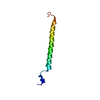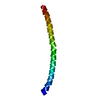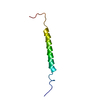| 登録情報 | データベース: PDB / ID: 6z0h
|
|---|
| タイトル | Structure of TREM2 transmembrane helix K186A variant in DPC micelles |
|---|
 要素 要素 | Triggering receptor expressed on myeloid cells 2 |
|---|
 キーワード キーワード | MEMBRANE PROTEIN / neurodegeneration / proteolysis |
|---|
| 機能・相同性 |  機能・相同性情報 機能・相同性情報
positive regulation of high-density lipoprotein particle clearance / regulation of toll-like receptor 6 signaling pathway / positive regulation of complement activation, classical pathway / detection of lipoteichoic acid / regulation of macrophage inflammatory protein 1 alpha production / regulation of hippocampal neuron apoptotic process / regulation of plasma membrane bounded cell projection organization / positive regulation of C-C chemokine receptor CCR7 signaling pathway / excitatory synapse pruning / positive regulation of CD40 signaling pathway ...positive regulation of high-density lipoprotein particle clearance / regulation of toll-like receptor 6 signaling pathway / positive regulation of complement activation, classical pathway / detection of lipoteichoic acid / regulation of macrophage inflammatory protein 1 alpha production / regulation of hippocampal neuron apoptotic process / regulation of plasma membrane bounded cell projection organization / positive regulation of C-C chemokine receptor CCR7 signaling pathway / excitatory synapse pruning / positive regulation of CD40 signaling pathway / negative regulation of triglyceride storage / negative regulation of cell activation / detection of peptidoglycan / positive regulation of macrophage fusion / import into cell / sulfatide binding / negative regulation of macrophage colony-stimulating factor signaling pathway / positive regulation of antigen processing and presentation of peptide antigen via MHC class II / negative regulation of fat cell proliferation / lipoteichoic acid binding / positive regulation of engulfment of apoptotic cell / positive regulation of establishment of protein localization / positive regulation of synapse pruning / microglial cell activation involved in immune response / negative regulation of toll-like receptor 2 signaling pathway / negative regulation of autophagic cell death / respiratory burst after phagocytosis / negative regulation of astrocyte activation / positive regulation of CAMKK-AMPK signaling cascade / semaphorin receptor binding / positive regulation of low-density lipoprotein particle clearance / positive regulation of microglial cell migration / detection of lipopolysaccharide / apolipoprotein A-I binding / Other semaphorin interactions / T cell activation via T cell receptor contact with antigen bound to MHC molecule on antigen presenting cell / CXCL12-activated CXCR4 signaling pathway / negative regulation of toll-like receptor 4 signaling pathway / negative regulation of neuroinflammatory response / high-density lipoprotein particle binding / negative regulation of p38MAPK cascade / very-low-density lipoprotein particle binding / cellular response to oxidised low-density lipoprotein particle stimulus / negative regulation of glial cell apoptotic process / complement-mediated synapse pruning / dendritic cell differentiation / microglial cell proliferation / semaphorin receptor complex / positive regulation of microglial cell activation / phagocytosis, recognition / amyloid-beta clearance by cellular catabolic process / low-density lipoprotein particle binding / negative regulation of NLRP3 inflammasome complex assembly / cellular response to lipoprotein particle stimulus / regulation of resting membrane potential / positive regulation of phagocytosis, engulfment / regulation of TOR signaling / cellular response to peptidoglycan / peptidoglycan binding / regulation of oxidative stress-induced neuron intrinsic apoptotic signaling pathway / positive regulation of chemotaxis / positive regulation of amyloid-beta clearance / positive regulation of potassium ion transport / semaphorin receptor activity / phosphatidylethanolamine binding / positive regulation of proteasomal protein catabolic process / positive regulation of osteoclast differentiation / negative regulation of amyloid fibril formation / cellular response to lipid / kinase activator activity / regulation of interleukin-6 production / dendritic spine maintenance / apoptotic cell clearance / negative regulation of interleukin-1 beta production / phagocytosis, engulfment / regulation of innate immune response / phosphatidylserine binding / pyroptotic inflammatory response / regulation of cytokine production involved in inflammatory response / negative regulation of cholesterol storage / cellular response to lipoteichoic acid / lipid homeostasis / amyloid-beta clearance / lipoprotein particle binding / positive regulation of ATP biosynthetic process / positive regulation of intracellular signal transduction / humoral immune response / regulation of lipid metabolic process / positive regulation of interleukin-10 production / apolipoprotein binding / plasma membrane raft / negative regulation of tumor necrosis factor production / social behavior / positive regulation of cholesterol efflux / positive regulation of TOR signaling / response to axon injury / negative regulation of canonical NF-kappaB signal transduction / negative regulation of cytokine production involved in inflammatory response / astrocyte activation / negative regulation of phosphatidylinositol 3-kinase/protein kinase B signal transduction類似検索 - 分子機能 : / Immunoglobulin V-set domain / Immunoglobulin V-set domain / Immunoglobulin-like domain superfamily / Immunoglobulin-like fold類似検索 - ドメイン・相同性 Triggering receptor expressed on myeloid cells 2類似検索 - 構成要素 |
|---|
| 生物種 |  Homo sapiens (ヒト) Homo sapiens (ヒト) |
|---|
| 手法 | 溶液NMR / simulated annealing |
|---|
 データ登録者 データ登録者 | Steiner, A. / Schlepkow, K. / Brunner, B. / Steiner, H. / Haass, C. / Hagn, F. |
|---|
| 資金援助 |  ドイツ, European Union, 2件 ドイツ, European Union, 2件 | 組織 | 認可番号 | 国 |
|---|
| Helmholtz Association | VG-NG-1039 |  ドイツ ドイツ | | European Communitys Seventh Framework Programme | 291763 | European Union |
|
|---|
 引用 引用 |  ジャーナル: Embo J. / 年: 2020 ジャーナル: Embo J. / 年: 2020
タイトル: gamma-Secretase cleavage of the Alzheimer risk factor TREM2 is determined by its intrinsic structural dynamics.
著者: Steiner, A. / Schlepckow, K. / Brunner, B. / Steiner, H. / Haass, C. / Hagn, F. |
|---|
| 履歴 | | 登録 | 2020年5月8日 | 登録サイト: PDBE / 処理サイト: PDBE |
|---|
| 改定 1.0 | 2020年9月16日 | Provider: repository / タイプ: Initial release |
|---|
| 改定 1.1 | 2020年10月28日 | Group: Database references / カテゴリ: citation / Item: _citation.journal_volume |
|---|
| 改定 1.2 | 2023年6月14日 | Group: Database references / Other / カテゴリ: database_2 / pdbx_database_status
Item: _database_2.pdbx_DOI / _database_2.pdbx_database_accession / _pdbx_database_status.status_code_nmr_data |
|---|
| 改定 1.3 | 2024年6月19日 | Group: Data collection / Database references / カテゴリ: chem_comp_atom / chem_comp_bond / database_2 / Item: _database_2.pdbx_DOI |
|---|
|
|---|
 データを開く
データを開く 基本情報
基本情報 要素
要素 キーワード
キーワード 機能・相同性情報
機能・相同性情報 Homo sapiens (ヒト)
Homo sapiens (ヒト) データ登録者
データ登録者 ドイツ, European Union, 2件
ドイツ, European Union, 2件  引用
引用 ジャーナル: Embo J. / 年: 2020
ジャーナル: Embo J. / 年: 2020 構造の表示
構造の表示 Molmil
Molmil Jmol/JSmol
Jmol/JSmol ダウンロードとリンク
ダウンロードとリンク ダウンロード
ダウンロード 6z0h.cif.gz
6z0h.cif.gz PDBx/mmCIF形式
PDBx/mmCIF形式 pdb6z0h.ent.gz
pdb6z0h.ent.gz PDB形式
PDB形式 6z0h.json.gz
6z0h.json.gz PDBx/mmJSON形式
PDBx/mmJSON形式 その他のダウンロード
その他のダウンロード 6z0h_validation.pdf.gz
6z0h_validation.pdf.gz wwPDB検証レポート
wwPDB検証レポート 6z0h_full_validation.pdf.gz
6z0h_full_validation.pdf.gz 6z0h_validation.xml.gz
6z0h_validation.xml.gz 6z0h_validation.cif.gz
6z0h_validation.cif.gz https://data.pdbj.org/pub/pdb/validation_reports/z0/6z0h
https://data.pdbj.org/pub/pdb/validation_reports/z0/6z0h ftp://data.pdbj.org/pub/pdb/validation_reports/z0/6z0h
ftp://data.pdbj.org/pub/pdb/validation_reports/z0/6z0h リンク
リンク 集合体
集合体
 要素
要素 Homo sapiens (ヒト) / 遺伝子: TREM2 / 発現宿主:
Homo sapiens (ヒト) / 遺伝子: TREM2 / 発現宿主: 
 試料調製
試料調製 解析
解析 ムービー
ムービー コントローラー
コントローラー













 PDBj
PDBj gel filtration
gel filtration